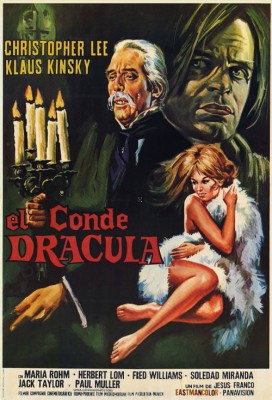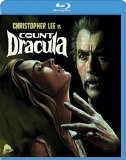| Reviews & Columns |
|
Reviews DVD TV on DVD Blu-ray 4K UHD International DVDs In Theaters Reviews by Studio Video Games Features Collector Series DVDs Easter Egg Database Interviews DVD Talk Radio Feature Articles Columns Anime Talk DVD Savant Horror DVDs The M.O.D. Squad Art House HD Talk Silent DVD
|
DVD Talk Forum |
|
|
| Resources |
|
DVD Price Search Customer Service #'s RCE Info Links |
|
Columns
|
|
|
Count Dracula (1970)
But Lee's participation, its comparative fidelity to Bram Stoker's original novel, and the growing if unfathomable cult surrounding director Franco has kept Count Dracula (El Conde Drácula) a desired title by some genre fans. Presumably convoluted rights issues to this Spanish-West German-Italian-Liechtensteinian (!) co-production precluded a U.S. Blu-ray edition until now, but Severin Films has bravely taken the plunge, loading their disc with scads of extra features.
Though uncredited, the film was the work of Harry Alan Towers, possible Soviet spy turned convicted pimp on the run turned movie producer. Towers had a knack for packaging pre-sold properties usually, as in this case, already in the public domain, with a complex mix of Anglo and Continental talent and financing. A few of his pictures are actually quite good, such as Don Sharp's The Face of Fu Manchu (1965), the first of five increasingly terrible thrillers starring Christopher Lee. Towers's business acumen was such that he was able to mount more than a few fairly lavish productions through the years using the same basic business model: The Call of the Wild (with Charlton Heston, 1972), Treasure Island (with Orson Welles, 1972), a pair of Harry Palmer spy films in the mid-1990s (Bullet to Beijing and Midnight in Saint Petersburg, with Michael Caine), and others.
Mostly though, Towers, who usually wrote the scripts under a pseudonym, Peter Welbeck, wasn't interested in whether his films were any good, just that they got made. Regardless of director, cheapness permeates nearly all of them. Lee was corralled into a number of Towers productions partly because he was multilingual and thus able to communicate with his sometimes non-English speaking co-stars, to say nothing of getting paid in European currencies that wouldn't necessarily be taxed in his native U.K. Franco, meanwhile worked cheap and in multiple languages as well, and their three paths collided in the late 1960s beginning with Blood of Fu Manchu (1968), the fourth and most appallingly bad of the series.
Lee had been unhappy with Hammer's treatment of Dracula in their sequels and with some justification. Towers and/or Franco hit upon the idea of luring Lee into their own Dracula project with the promise of faithfully adapting Stoker's original novel, which the resulting film more or less does, despite some minor changes.
As noted in my other reviews, the general rule with Franco is that he started off making cheap but promising films in the early-to-mid 1960s, but that as a filmmaker he got steadily worse. Blood of Fu Manchu is so terrible that to call it amateurish would be an insult to amateur filmmakers. Incoherent, seemingly bereft of thought to composition (or, literally, focus) his subsequent films are typically slapdash. Gradually he drifted into the sleaziest of exploitation pictures and, eventually, direct-to-video porn. Franco's defenders, as Christophe Gans enthusiastically and intelligently argues, suggest that the director wasn't concerned with narrative storytelling or even coherence particularly, that he might be likened to a free-form jazz musician. I see where that line of thought comes from; I just don't buy it.
Count Dracula is, uncharacteristic of Franco during this period, much more staid and straightforward, though far from good. It's a filmed record of the book, more or less, but less artful than an average episode of Kojak, though filmed in a similar get-it-done style. Franco became enamored of the zoom lens early in his career, and particularly in the film's second-half it's almost constantly moving in-and-out. Partly it's a sort of shorthand to enable longer, less interrupted takes. But quickly it draws motion sickness-inducing attention to itself, though it's used much less here than, for instance, Franco's two Fu Manchus.
Filmed in Barcelona (making for a lot of incongruous architecture during the story's London scenes), the locations provide much needed atmosphere, but interiors are generally overly and flatly-lit. The actors (including Franco, in a small part as Van Helsing's servant, and dubbed with an overemphatic Cockney accent) are at sea, and Franco seems disinterested in the material except for the couple of visits to a padded cell with Klaus Kinski (as Renfield) and the major set pieces. Even these, however, are pretty ludicrous, none more so than when our heroes are confronted by taxidermied animals come to life by out-of-frame stagehands pushing their stiff, stuffed corpses toward the camera lens. Franco almost pulls off a few bits, like Jonathan Harker's coach ride to Dracula's castle: the howling wolves running alongside the coach would have been great had they not been portrayed by playful German Shepherds.
The piecemeal nature of the film's production doesn't help. Kinski, who later claimed to have been tricked into appearing in the picture, has no dialogue (a few off-screen screams don't sound like his voice) and doesn't interact with the major players. The one scene between Lee and Herbert Lom (as Van Helsing) reportedly was shot with Lee and Lom working on different days.
Video & Audio
Curiously, Count Dracula is presented in 1.37:1 standard size rather than 1.66:1 or 1.85:1 widescreen. Even more strangely, that aspect ratio appears correct. The framing is very tight throughout, so unless it's cutting off side information from some sort of hard-matted widescreen (as has been done with many ‘60s Disney titles on home video) the 1.37:1 ratio may well be intended. The image is "remastered in high-definition for the first time ever" reports Severin and, while a huge improvement over previous home video versions, still seems a bit soft and slightly lifeless in terms of color and contrast, though acceptable. A brief, previously missing scene involving a distraught mother has been reinstated using a 16mm Spanish source. The film is presented in 2.0 English mono only, though title elements in several different languages are offered as an extra feature. Region-free.
Extra Features
Numerous supplements include Cuadecuc, Vampir (1971), an experimental feature in high-def running 66 minutes directed by Pere Portabella on the set of Count Dracula. Bizarre yet fascinating, it's an inspired extra. Equally imaginative is a nearly 90-minute abridged reading of Dracula by Lee, accompanied by stills and poster art.
Also included is a fine audio commentary track by historian David Del Valle and Maria Rohm, she the actress-widow of Towers; "Beloved Count," an archival interview with Franco (in English); "A Conversation with Jack Taylor" (who plays Quincy Morris in the film); "Handsome Harker: An Interview with Actor Fred Williams"; "Stake Holders," an appreciation by Christophe Gans; and a German trailer.
Parting Thoughts
As excited as I was to finally see a decent (if not definitive) version of Count Dracula, I also ended up watching it over three nights as it put me to sleep faster than a bottle of NyQuil. The extras help enormously to put the film, minor as it is, into context, and genre fans really need to see it at least once. Drink lots of coffee beforehand. Recommended.
Stuart Galbraith IV is the Kyoto-based film historian and publisher-editor of World Cinema Paradise. His new documentary and latest audio commentary, for the British Film Institute's Blu-ray of Rashomon, and commentary track for Arrow Video's Battles without Honor and Humanity are newly available.
|
| Popular Reviews |
| Sponsored Links |
|
|
| Sponsored Links |
|
|
| Release List | Reviews | Shop | Newsletter | Forum | DVD Giveaways | Blu-Ray | Advertise |
|
Copyright 2024 DVDTalk.com All Rights Reserved. Legal Info, Privacy Policy, Terms of Use,
Manage Preferences,
Your Privacy Choices | |||||||















